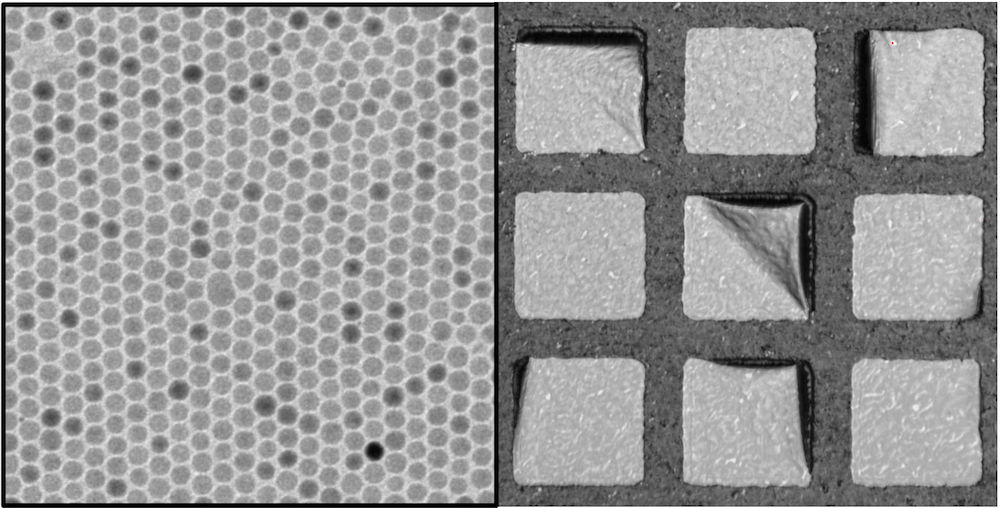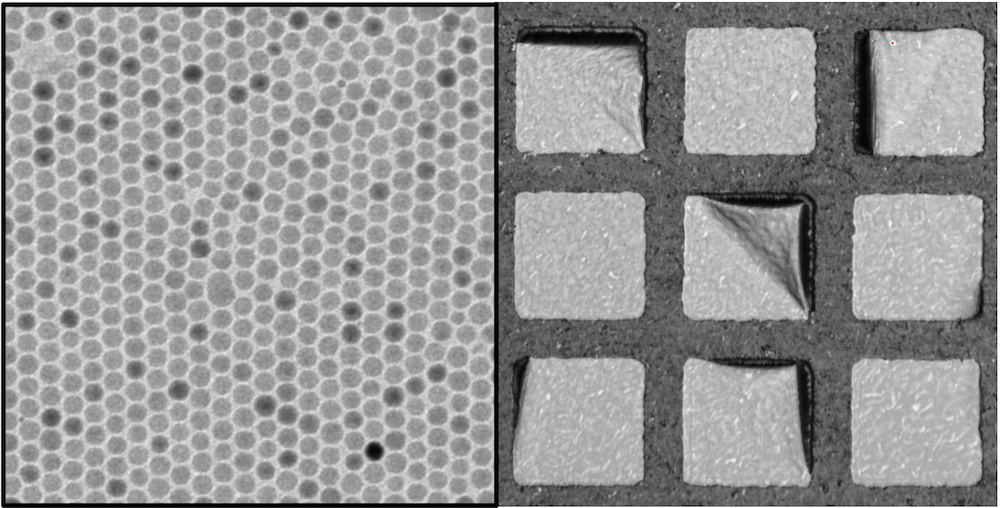Magnetic Field Maneuvers Magnetite Monolayers
Suppose you want to make a tiny robot to perform surgery inside a human patient. To avoid damaging healthy tissue and to squeeze into tight spots, the robot should be squishy. And manipulating the robot’s movements with magnetic fields would make sense, as tissues don’t respond to magnetism. But what material would you use for the robot’s limbs? Magnetic materials are stiff and brittle. Embedding tiny particles of them in a rubbery matrix could work, but the thinner—and therefore bendier—you make the composite material, the less it responds to a magnetic field. Heinrich Jaeger of the University of Chicago, Monica Olvera de la Cruz of Northwestern University, Illinois, and their collaborators have now overcome that obstacle by making thin, flexible sheets out of self-assembled nanoparticles of magnetite [1]. Even a modest field of 100 milliteslas can lift a sheet and bend it by 50°, they found.
At room temperature, magnetite (Fe3O4) is ferrimagnetic—that is, the magnetic moments in its two sublattices align in opposite directions but with unequal magnitudes, yielding a net magnetization. The smaller a ferrimagnet, the greater the chance that it has a single domain, and therefore the lower the temperature at which the domain’s magnetization will flip. When the sample size gets down to a few tens of nanometers, a ferrimagnet made of randomly flipping particles becomes, in effect, a paramagnet—that is, it lacks a net magnetization and is attracted by an applied magnetic field. The attraction can be strong. The discoverers of this phenomenon in 1959 dubbed it superparamagnetism [2].
The researchers realized that a sheet made from a single layer of superparamagnetic particles could serve as a viable material for the magnetic actuation of small soft robots. To create the layers, they suspended magnetite nanoparticles in droplets of water coated with an organic solvent. The solvent attracted the nanoparticles, which migrated to a droplet’s surface. The water slowly evaporated, leaving behind a layer of closely packed nanoparticles draped on the droplet’s support structure, a square copper grid. Each of the 20 × 20 µm squares supported a single sheet. As shown in the figure, some of the sheets happened to have a single unattached corner.
In their experiments, the researchers applied a magnetic field perpendicular to the sheets and measured the corners’ upward deflections through an optical microscope. The amount of deflection exceeded the team’s expectations—that is, the magnetic forces induced within the closely packed monolayer turned out to be surprisingly strong. To probe just how much they could manipulate the material, the researchers coated a sheet of aluminum, which is nonmagnetic, with one of their magnetic monolayers. On applying the magnetic field, they observed a deflection at a field of 150 milliteslas, even though the aluminum sheet was 1000 times thicker and 100 times stiffer than the monolayer itself.
To investigate the origin of the strong magnetic response, the team developed analytic and numerical models. The models pointed to the key role played by how the magnetic nanoparticles respond collectively both to an applied field and to each other. For small values of the external magnetic field B, the deflection increased as B1.8. For stronger fields, the deflection eventually stopped increasing. The models also revealed that sheets could be made to twist by changing the magnetic field’s orientation, an additional mode of motion that could prove useful.
Bioengineer Eric Diller of the University of Toronto builds magnetically actuated robots with a view toward medical and biological applications. “This work is quite interesting,” he says. “The tendency of small magnets to lose their magnetism has limited their applications and has limited what kind of sophisticated manipulation we can exert on small devices, such as deforming arms of microrobotic devices for cell manipulation.”
–Charles Day
Charles Day is a Senior Editor for Physics Magazine.
References
- E. P. Esposito et al., “Actuating superparamagnetic nanoparticle monolayers,” Proc. Natl. Acad. Sci. U.S.A. 122, e2424073122 (2025).
- C. P. Bean and J. D. Livingston, “Superparamagnetism,” J. Appl. Phys. 30, S120 (1959).





